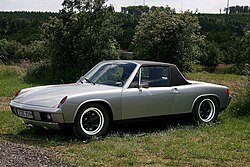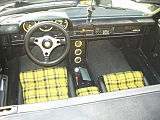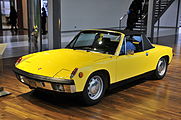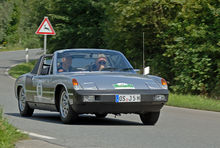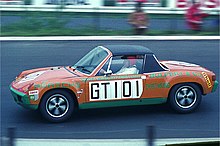Porsche 914
| Porsche | |
|---|---|
|
VW-Porsche 914/4 (1969-1976)
|
|
| 914 | |
| Production period: | 1969-1976 |
| Class : | Sports car |
| Body versions : | Coupe |
| Engines: |
Gasoline engines : 1.7–2.0 liters (59–81 kW) |
| Length: | 3985 mm |
| Width: | 1650 mm |
| Height: | 1230-1240 mm |
| Wheelbase : | 2450 mm |
| Empty weight : | 950-980 kg |
| Previous model | Porsche 912 |
| successor | Porsche 924 |
The Porsche 914 is a sports car with a longitudinally installed mid-engine ( air-cooled boxer engine ) and rear-wheel drive . The coupé , which originated from a cooperation between Volkswagen and Porsche , was built in almost 120,000 units from autumn 1969 to early 1976.
Most of the 914 (115,631 copies) were manufactured by Karmann in Osnabrück as VW-Porsche (914/4) . They had a 1.7-liter four-cylinder boxer engine from the VW Type 4 with 80 hp (59 kW). The Porsche 914/6 with the 110 hp (81 kW) 2.0-liter six-cylinder boxer engine from the Porsche 911 T was assembled at Porsche in Stuttgart. Of these, 3353 vehicles were manufactured.
The Targa roof could be stowed in the rear trunk. The parking brake is located to the left of the driver's seat; Between the seats there is a narrow emergency seat that officially turns the car into a three-seater.
Development history
In the second half of the 1960s, VW was looking for a sporty model to replace the Karmann Ghia ( Type 34 ) based on the VW Type 3 . Porsche did not have an inexpensive entry-level model since the 356 was discontinued in 1965 and the 912 - a 911 with the 90 hp (66 kW) four-cylinder engine of the 356 C - could not hold its own against the sports cars of the competition.
Ferry Porsche and the VW boss Heinrich Nordhoff (whose daughter Elisabeth was married to Ferry's nephew Ernst Piëch), who is closely related to the Porsche family, agreed with a handshake that Porsche would use its sports car know-how to develop a joint model that should be sold separately as a VW variant and as a Porsche vehicle. VW would ensure low production costs through high sales; Porsche should be rewarded for the development work through the low unit costs that can be achieved. Karmann was to manufacture the bodies .
So it looked like a perfect win-win deal . When the first 914 prototype was presented on March 1, 1968, Nordhoff was seriously ill. He died on April 12, 1968. His successor at VW, Kurt Lotz , was not associated with the Porsche dynasty and is said to have not recognized the verbal agreement between Nordhoff and Ferry Porsche. He is said to have been of the opinion that VW had all rights to the body, which is why Porsche would only get it in return for a contribution to the tool costs. The price and marketing concept of the 914 had already failed before the start of series production.
As a compromise, VW and Porsche founded "VW-Porsche Vertriebs GmbH" ( VG for short ) in early 1969 for marketing and sales of the 914 , which soon moved from the Porsche site in Stuttgart to nearby Ludwigsburg. This is the reason why factory vehicles of the 914/4 can usually be seen in photos with the registration number "LB".
Name, image and marketing
In Europe, the car was then sold by VG as "VW-Porsche". This led to the mockery as "Volks-Porsche" (also: "Volksporsche") or even as "VoPo", although the marketing director of the VG, Fritz Huschke von Hanstein , had urgently requested this GDR abbreviation - Volkspolizei - at the press presentation not to be used for the 914.
In addition to this image and the unclear positioning between VW and Porsche, there were processing defects in the first copies and susceptibility to rust. As older used cars, they were often neglected by their owners, but were all the more tuned.
In North America, the 914 was sold as a Porsche because of the joint sales network of Audi and Porsche, and it was given the corresponding logos and coats of arms.
But the US models of the 914 with four-cylinder engines were also manufactured by the Volkswagen factory . The six-cylinder models were made by Porsche, and that is also stated in the vehicle registration document. The bodyshell supplied by Karmann from Osnabrück was completed at Porsche in Stuttgart.
The Federal Motor Transport Authority has all models of the Porsche 914/4 under the manufacturer key number (HSN) 0600, which is assigned to VW. The Porsche 914/6 are listed under the key number 0583/309, i.e. under a Porsche HSN.
Series models
From autumn 1969 to summer 1972, the 914/4 was offered with the 59 kW (80 hp) 1.7 liter injection engine ( D-Jetronic ) of the VW 411 E , which accelerated the 940 kg car to 177 km / h . In 1970 the car without special equipment cost DM 12,250. The 914/6 with the 81 kW (110 PS) six-cylinder boxer engine of the Porsche 911 T and a top speed of 201 km / h cost DM 19,980.
Since the comparable Targa model of the Porsche 911 T with more power (125 hp) only cost around 16 percent more (23,199 DM), only 2,657 buyers opted for the 914/6 in the first model year; In the following years the sales figures collapsed with 432 (1971) and 229 (1972) copies and the 914/6 was no longer offered from mid-1972 (model year 1973).
For the 914/6, fender flares made of steel (M471) could be ordered as additional equipment, which gave the car the appearance of the so-called 914/6 GT. Another extra was the semiautomatic four-speed gearbox from the Porsche 911, called the “Sportomatic”, which few buyers opted for.
For the 1973 model year, some weaknesses of the 914 were eliminated: Among other things, the gearshift, which was criticized as very fickle, was improved and the rigid passenger seat was replaced by an adjustable one. The 914/6 was discontinued and, in return, VW expanded its program with the four-cylinder engine, which was also enlarged to 2.0 liter displacement and now developed 74 kW (100 hp) with D-Jetronic . It almost achieved the performance of the 7 kW (10 PS) more powerful, but around 40 kg heavier car with a six-cylinder engine.
With the discontinuation of the 914/6, the four-cylinder was simply called the 914 1.7 or 914 2.0.
For the 1974 model year, the model got a 1.8 liter engine in August 1973. In Europe it developed 85 PS (63 kW) with two Solex carburetors , in the USA with a catalytic converter and L-Jetronic it only achieved 76 PS (56 kW). Previously, due to new emissions regulations, some export versions of the 914 1.7 had been throttled to just 72 hp (53 kW). With the introduction of the 1.8-liter engine, the model upgrade of the engine supplier VW was taken over. The 1.8-liter engine was originally developed for its VW 412 S model and also replaced the 1.7-liter engine there.
For the 1975 model year, the previous bumpers made of pressed steel were replaced by rubber-coated safety bumpers. In the US versions, they sat on damping elements on the body and could absorb an impact of up to 8 km / h. The damper elements were reversibly deformed. For other countries, the bumpers were attached directly to the body. For the states of California and Maryland, the US versions also received buffer horns introduced as early as 1974 model year. The 914 now had square auxiliary headlights.
In the 1976 model year, only 4,075 units were produced, all of which were intended for the US market.
The US models had - depending on the year of manufacture and state - catalytic converters, warning systems for putting on seatbelts and reinforced bumpers as well as side impact protection in the doors. All North America versions had side reflectors and a single-color parking light / indicator combination in orange instead of white and yellow. Because they were marketed as a “real” Porsche, they initially had a gold, later a chrome “PORSCHE” logo on the grille of the engine cover and a Porsche crest on the steering wheel. A Porsche crest on the front hood of the US models did not exist ex works, but was subsequently installed, in some cases by Porsche dealers even before delivery.
Conversions and special models
Quite often, four-cylinder models were converted to the technology of the 914/6 by converting the engine, brakes and wheel hubs. Such conversions can be recognized by the chassis number and the manufacturer name: four-cylinder models (including their conversions) come from the manufacturer Volkswagen and have chassis numbers beginning with the digits "47" (internal type number at VW) and the model year end digit (start of the model year is the Month of August of the previous year) (e.g. "475 ..." for vehicles from 8/74 to 7/75); The 914/6 built by Porsche have chassis numbers that start with 914.
Thanks to the modular system from VW and Porsche, the 914 is easy to change. Tuned VW Type 4 engines fit. The air-cooled boxer engines up to 3.2 liters displacement, braking systems of the later 911 models and tie rods of the Porsche 930 can be installed by Porsche without any major problems .
In Germany, among other things, the conversion using the Lenner body kit was popular. It comprised flares, flat front fenders (i.e. without the turn signal "humps") and a large rear wing on the rear trunk lid.
Porsche 914/6 R.
In racing, the Porsche 914/6 R , modified by the so-called “sports kit”, was used in particular . Because of its approval in the GT class of the FIA , the name Porsche 914/6 GT prevailed for him .
Around 32 Porsche 914/6 GT were manufactured in the factory, plus around 400 official GT kits from Porsche. Since the GTs had chassis numbers from the current production, an exact identification is very difficult. The racing version of the 914/6 GT had flared fenders, body reinforcements, an additional front oil cooler and a 2.0-liter engine with dual ignition .
The 914/6 GT was quite successful in circuit racing but not in rallies.
Porsche 916
The Porsche 916 was a powerful variant of the Porsche 914/6, of which only eleven vehicles were built in 1971. There was a prototype with a body from the current 914/6 production (chassis number 914 1430195) and a pilot series of ten chassis numbers from 914 2330011. All eleven vehicles were built individually and with different - mostly sporty and elegant - interior fittings. The fender flares known from the 914/6 GT have been supplemented with a fixed steel roof and various welded reinforcements for greater rigidity .
The engine of the first three cars was the 2.4-liter six-cylinder engine of the Porsche 911 S, which accelerated the 1000 kg vehicle with its 140 kW (190 hp) to 100 km / h in 7 seconds and up to 233 km / h let reach. The other Porsche 916 had the 2.7 liter engine of the 911 Carrera with 154 kW (210 hp). Of the eleven cars produced, the Porsche and Piëch families allegedly reserved five models, the others were sold to very good customers.
Porsche 914/8
The Porsche 914/8 finally has the eight-cylinder engine of the Porsche 908/3 (an air-cooled 3.0-liter boxer engine) and was built only twice: The first copy (. Chassis 914 111) is a 220 kW (300 hp) Test vehicle for Ferdinand Piëch . This red 914/8 is particularly noticeable because of the wide, folding double headlights. The other 914/8 was a present for Ferry Porsche on his sixtieth birthday (chassis no. 914 006). This 192 kW (260 PS) version is silver, was street legal (SR 3000) and looked very similar to the production model.
Technical data of the series versions
The Porsche 914 was produced from 1969 to 1976 in the following versions:
| Porsche 914: | 914/4 1.7 (Targa) | 914/6 (Targa) | 914 1.8 (Targa) | 914 2.0 (Targa) |
|---|---|---|---|---|
| Engine: |
Four - cylinder boxer engine ( four-stroke ) intake manifold injection Bosch D-Jetronic |
Six-cylinder -Boxermotor (four-stroke) , two triple - downdraft carburetor |
Four-cylinder boxer engine (four-stroke) downdraft carburetor |
Four-cylinder boxer engine (four-stroke) intake manifold injection Bosch D-Jetronic |
| Displacement: | 1679 cc | 1991 cc | 1795 cc | 1971 cc |
| Bore × stroke: | 90 × 66 mm | 80 × 66 mm | 93 × 66 mm | 94 × 71 mm |
| Performance at 1 / min: | 59 kW (80 PS) at 4900 | 81 kW (110 PS) at 5800 | 63 kW (85 PS) at 5000 | 74 kW (100 PS) at 5000 |
| Max. Torque at 1 / min: | 136 Nm at 2700 | 160 Nm at 4200 | 138 Nm at 3400 | 160 Nm at 3500 |
| Compression: | 8.2: 1 | 8.6: 1 | 8.6: 1 | 8.0: 1 |
| Valve control: |
overhead valves , a central camshaft |
overhead camshafts (one per cylinder bank) | overhead valves, a central camshaft |
|
| Cooling: | Air cooling (fan) | |||
| Transmission: | 5-speed gearbox, rear-wheel drive | |||
| Front suspension: | Independent suspension on wishbones and shock absorber struts | |||
| Rear suspension: | Independent suspension on semi-trailing arms | |||
| Rear suspension: | Coil springs | |||
| Body: | Self-supporting steel body | |||
| Track width front / rear: | 1337/1374 mm | 1361/1382 mm | ||
| Wheelbase : | 2450 mm | |||
| Tires: | 165 SR 15 or 185/70 SR 15 | 165 HR 15 or 185/70 HR 15 | 165 SR 15 or 185/70 SR 15 | 165 HR 15 or 185/70 HR 15 |
| Dimensions L × W × H: | 3985 × 1650 × 1220 mm | 3985 × 1650 × 1220 mm | 3985 × 1650 × 1230 mm | |
| Empty weight : | 940 kg * | 985 kg * | 950 kg | |
| Top speed: | 186.5 km / h * | 207 km / h * | 178 km / h | 190 km / h |
| Acceleration 0 - 100 km / h: | 13.3 s | 8.7 s * | 12.0 s | 10.5 s |
* Measurement of "auto motor und sport" (test reports in issues 22/1969 and 8/1970)
Technical data of the sport / street versions
For customers for whom the series versions were too good, Porsche offered sportier vehicles, some of which were approved for use on public roads.
| Porsche 914/916: | 914/6 R so-called 914/6 GT |
916 (3 vehicles) | 916 (8 vehicles) | 914/8 (custom-made for Ferry Porsche) | 914/8 (test vehicle from Ferdinand Piëch) |
|---|---|---|---|---|---|
| Engine: | 6-cylinder boxer engine (four-stroke) ( carburettor ) |
6-cylinder boxer engine (four-stroke) ( injection ) |
8-cylinder boxer engine (four-stroke) (injection) |
||
| Displacement: | 1991 cc | 2311 cc | 2653 cc | 2997 cc | |
| Bore × stroke: | 80.0 x 66.0 mm | 84.0 x 70.4 mm | 90.0 x 70.4 mm | 85 × 66 mm | |
| Performance at 1 / min: | 140 kW (190 PS) to 154 kW (210 PS) |
140 kW (190 hp) | 154 kW (210 hp) | 192 kW (260 hp) at 7500 | 220 kW (300 PS) at 8200 |
| Max. Torque at 1 / min: | 319 Nm / 6700 | ||||
| Compression: | |||||
| Valve control: | two overhead camshafts | ||||
| Cooling: | Air cooling (fan) | ||||
| Transmission: | 5-speed gearbox, rear-wheel drive | ||||
| Front suspension: | Independent suspension on wishbones and shock absorber struts | ||||
| Rear suspension: | Independent suspension on semi-trailing arms | ||||
| Front suspension: | longitudinal torsion spring bars | ||||
| Rear suspension: | Coil springs | ||||
| Body: | Self-supporting steel body in lightweight construction with firmly bolted roof | Self-supporting steel body with welded steel roof, flared fenders, reinforced body, enlarged engine flap, individual interior fittings | Self-supporting steel body with a fixed roof | ||
| Track width front / rear: | |||||
| Wheelbase : | 2450 mm | ||||
| Tires rim: | |||||
| Dimensions L × W × H: | 3985 × 1650 × 1240 mm | ||||
| Empty weight : | |||||
| Top speed: | 233 km / h | 245 km / h | 250 km / h | ||
Graphic representation of the development
| Porsche 914 road vehicle history from 1969 to 1976 | |||||||||||||||||||||
| model | power | 1960s | 1970s | ||||||||||||||||||
|---|---|---|---|---|---|---|---|---|---|---|---|---|---|---|---|---|---|---|---|---|---|
| 0 | 1 | 2 | 3 | 4th | 5 | 6th | 7th | 8th | 9 | 0 | 1 | 2 | 3 | 4th | 5 | 6th | 7th | 8th | 9 | ||
| 914 | |||||||||||||||||||||
| 914/4 | 59 kW / 80 PS | ||||||||||||||||||||
| 914/6 | 81 kW / 110 PS | ||||||||||||||||||||
| 914 1.7 | 59 kW / 80 PS | ||||||||||||||||||||
| 914 1.8 | 63 kW / 85 PS | ||||||||||||||||||||
| 914 2.0 | 74 kW / 100 PS | ||||||||||||||||||||
| 914 2.0 (only in US) | 65 kW / 88 PS | ||||||||||||||||||||
literature
- Thomas Lang: VW Porsche 914 - The sports car legend . HEEL Verlag, Königswinter 2009, ISBN 978-3-89880-914-6 . Development history, sport and purchase advice.
- Tom Grünweg: Resurrection from ruins: America loves the Volksporsche. In: Spiegel Online . August 4, 2009. Retrieved January 7, 2017 .
Web links
- Literature by and about Porsche 914 in the catalog of the German National Library
- Official Volkswagen profile for the VW-Porsche 914
- Technical data for the Porsche 914 models
- Article about Porsche 914/6 by Tony Dron
Individual evidence
- ↑ volkswagen-classic.de: VW-Porsche 914 ( Memento from June 12, 2017 in the Internet Archive )
- ↑ HSN list at AutoAmpel.de
- ^ Auto motor und sport, issue 8 from April 11, 1970
